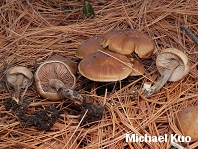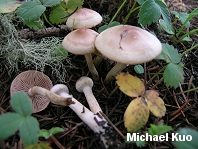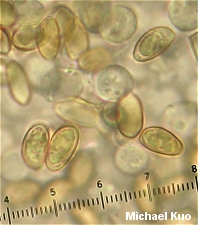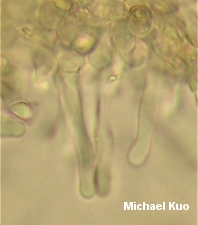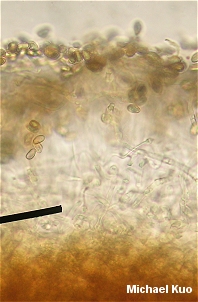| Major Groups > Gilled Mushrooms > Dark-Spored > Hebeloma > Hebeloma mesophaeum |

|
Hebeloma mesophaeum [ Basidiomycetes > Agaricales > Strophariaceae > Hebeloma . . . ] by Michael Kuo Members of the Hebeloma mesophaeum species group share the following features:
In North America Hebeloma mesophaeum appears limited to association with conifers, but the reigning European concept of the species (Vesterholt, 2005) is quite broad and allows for "nearly all types of habitat." I have found members of the mesophaeum group under Engelmann spruce and under eastern white pine. Description: Ecology: Mycorrhizal with various conifers, including pines, spruces, and firs; usually growing gregariously; fall, winter, and spring (also in summer at higher elevations); widely distributed in North America--at least as a species group. Cap: 2-7 cm; convex, becoming broadly convex, broadly bell-shaped, or nearly flat; sticky when fresh; bald; brown to pinkish brown over the center; often paler toward the margin; the margin with or without veil remnants. Gills: Attached to the stem, often by a notch; close or crowded; creamy or faintly pinkish when young, becoming brownish. Stem: 2-9 cm long; up to 1 cm thick; more or less equal; silky; whitish at first, discoloring brownish to brown, from the base up, with maturity; sometimes with a faint or more prominent ring zone. Flesh: Whitish. Odor and Taste: Odor radishlike, or not distinctive. Taste radishlike or bitter. Chemical Reactions: KOH negative on cap surface. Spore Print: Brown to pinkish brown. Microscopic Features: Spores 8.5-11 x 5-7 µ; ellipsoid; very finely verrucose (nearly smooth); not dextrinoid. Cheilocystidia to about 70 x 7 µ; abundant; cylindric above a ventricose base. Pileipellis an ixocutis 50-200 µ thick. REFERENCES: (Persoon, 1828) Quélet, 1872. (Fries, 1838; Saccardo, 1887; Kauffman, 1916; Smith, Smith & Weber, 1979; Smith, Evenson & Mitchel, 1983; Weber & Smith, 1985; Arora, 1986; Vesterholt, 2005; McNeil, 2006; Miller & Miller, 2006.) Herb. Kuo 07250602, 07270601, 11241101, 12031101. Hebeloma strophosum, traditionally separated on the basis of its smaller spores and more persistent veil (leaving a fibrillose ring on the stem), is regarded as a synonym by Vesterholt (2005). Further Online Information: Hebeloma mesophaeum in Smith, Evenson & Mitchel (1983) |
© MushroomExpert.Com |
|
Cite this page as: Kuo, M. (2012, March). Hebeloma mesophaeum. Retrieved from the MushroomExpert.Com Web site: http://www.mushroomexpert.com/hebeloma_mesophaeum.html |
